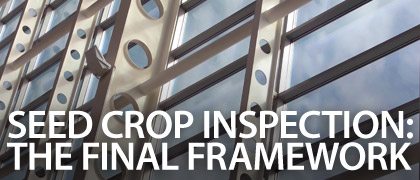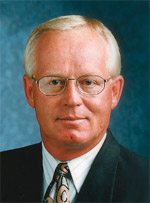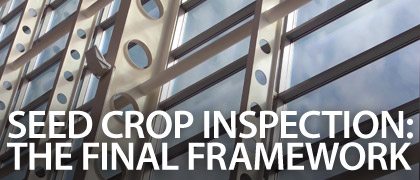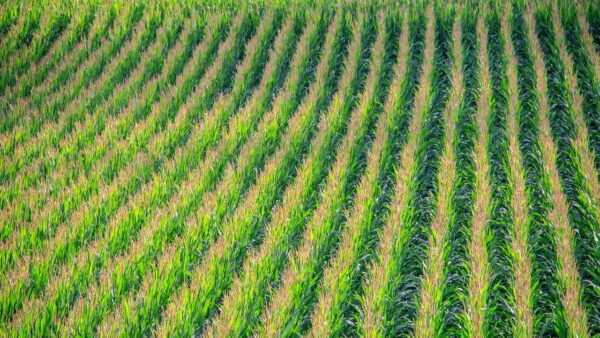
After exploring different options for alternative service delivery of seed crop inspection and garnering feedback from industry, the Canadian Food Inspection Agency has now finalized a national framework.
Since first announcing its intent to step away from direct delivery of pedigreed seed crop inspection, the CFIA has been working closely with the seed industry to develop a national framework for alternative service delivery of seed crop inspection. Central to the process was the creation of a seed industry-government working group (IGWG) made up of the CFIA, Canadian Seed Growers’ Association, Canadian Seed Trade Association and Canadian Seed Institute.
According to Dale Adolphe, executive director of the CSGA, communication has been ongoing and tight deadlines were followed. “Last November, an information package was sent out that outlined ASD in terms of three models — first-, second- and third-party inspection of seed crops — and asked for expressions of interest for providing the service and/or providing inspections,” he explains.
The Final Model
Over the winter, the pros and cons of all three models were discussed and early this spring the IGWG decided to move forward with only the third-party model. Rod Lister, media relations officer for CFIA, says the new framework for ASD of seed crop inspection involves the following:
• Authorized seed crop inspection services (ASCIS) must have a third-party/arm’s-length relationship to their clients. This reduces the potential for conflict of interest and provides independent quality assurance.
• The country has been divided geographically into nine regions and requires ASCIS to commit to servicing one or more regions. This allows competitive choice for growers and for small, medium and large ASCIS to establish in each region.
• ASCIS are required to ensure each seed crop grower has at least one offer of service for his or her fields. This commitment will be in place during the transition.
“These changes should ensure that the integrity and reputation of Canada’s seed certification system is maintained, that a competitive environment is fostered and that crop inspection will be provided to all growers through the transition to private industry,” says Lister. “As the ASD transition model is implemented, it will be regularly reviewed and adjusted if necessary. It is expected that the industry will take on more responsibility and leadership and that market forces will provide for assurances of service delivery to growers.”
Adolphe says a second information package went out in March that “outlined the decision to move forward with only the third-party model and asked again for continued expression of interest under a third-party model. Supposedly anyone that expressed an interest initially as a first- or second-party provider either dropped off the list or expressed their interest in the third-party model.” Another communication was made in early May asking interested parties to identify and confirm the number of inspectors they required for training in 2013.
According to Adolphe, the response to CFIA’s request for expressions of interest was quite strong. “Nearly 30 individuals and companies responded to the CFIA request indicating they were interested in being a service provider of the third-party model,” he says. “Most of them were one region operations but one was prairie-wide and two expressed an initial interest of being nationwide. I think there had been considerable concern on the part of some companies and seed growers as to whether or not they would be able to get their crops inspected in 2014. Those concerns should be eased by the large number of responses CFIA received.”
 |
“I think there had been considerable concern on the part of some companies and seed growers as to whether or not they would be able to get their crops inspected in 2014. Those concerns should be eased by the large number of responses CFIA received.” — Dale Adolphe |
Key Points for Growers
One important aspect of the new framework, says Adolphe, is that inspector training in 2013 is only on the crops listed in section 2 and section 3 of CSGA’s Circular 6. “Those two sections encompass cereals and pulses as well as some special crops and flaxseed,” he says. These crops typically represent about 80 per cent of the fields and acres inspected.
“Other inspections will continue in 2014 to be performed by CFIA unless service providers are able to hire some of the more highly-trained inspectors that have been working as casual or seasonal inspectors for CFIA in past years,” explains Adolphe. “This is expected to happen and it will be important for the service providers and CFIA seasonal staff to be in contact with each other to finalize those employment arrangements.”
However, Adolphe says the most critical message that must be communicated to seed growers is that beginning in 2014, it will be their responsibility to confirm a service provider that will inspect their crops. “Making application to CSGA for seed crop inspection has in the past resulted in a CFIA inspection of the fields,” he explains. “In 2014, inspections will not be an automatic result of an application for inspection to CSGA — they will be the result of the seed grower confirming with an inspection service to have the fields inspected and then designating that service provider on their application to CSGA.”
Therefore, seed growers, when making application for inspection to CSGA, will have to designate the inspection service being used for each field to be inspected. “Likely in the first few years of ASD, this will mean using more than one inspection service because not all inspection services are likely to have the qualified inspectors needed to inspect high generation seed crops, plots or crops outside of section 2 and section 3,” says Adolphe.
Going forward, in January of each year, Adolphe says CSGA will post to its website a list of service providers operating in the upcoming year. “The listing will include information related to the contact co-ordinates for the service providers, the region(s) in which each of the service providers is operating, and the crop kinds and pedigree classes their inspectors are qualified to inspect,” he says. “It will be important for all seed growers to make inspection arrangements with a service provider early so that the seed grower can designate the service provider when making application for inspection to CSGA.”
Looking Ahead
Training will be a major focus of the CFIA’s efforts in 2013, targeting those crop kinds listed in sections 2 and 3 of the CSGA’s Circular 6 (cereals and pulses including soybeans).
“We do not anticipate changes to the ASD model for 2013–2014,” says Lister. “However, applicant ASCIS and licensed seed crop inspectors (LSCI) will be receiving further information on a regular basis as the training and licensing process continue and the 2014 growing season approaches.”
Lister says the next steps are to conduct classroom and practical training for private inspectors in 2013 and for ASCIS to agree to the minimum(s) for the region(s) for which they will be offering service. “Potential ASCIS and LSCI will be issued licences for 2014 after December 31, 2013. After licences have been issued, the CFIA will publish a list of ASCIS and LSCI. To take advantage of competitive pricing and ensure they have a service provider, growers are encouraged to make arrangements with ASCIS as early as possible,” he says.
While the majority of the industry is now on board with the third-party model and the response for expressions of interest has been high, Adolphe says further communication is definitely needed in 2013 and beyond.
“I think it will be necessary for the frequency of communication to increase. There is still a lot that needs to be done before 2014 rolls around. Seed growers need to be fully aware of their new responsibilities under ASD. New inspectors need to be trained in 2013. Service providers need to employ inspectors for 2014. CFIA needs to identify where gaps may exist in inspection coverage, meaning they will fill in where no service or no qualified service is available.
“Because it is expected the transition to alternative service delivery will take a few years, communication is critical,” says Adolphe.
Julie McNabb
Scope: Alternative Service Delivery FrameworkWith the support of the industry-government working group (IGWG), the Canadian Seed Growers’ Association and the Canadian Food Inspection Agency are implementing a regional model that will focus on authorized seed crop inspection services (ASCIS) with an arm’s-length relationship to the producer of the seed crop being inspected. This model was designed to address the three main goals of the IGWG: 1. Maintain the integrity and reputation of Canada’s seed certification system. 2. Foster a competitive environment and a choice of ASCIS for seed growers. 3. Create an environment in which seed crop inspection services are available to all growers. The minimum number of inspections is set so that at least one ASCIS would be required to provide seed crop inspection services to each and every seed grower. The calculation of minimums includes a ten per cent buffer, increasing the likelihood that at least one ASCIS in the region is below its minimum number of inspections, resulting in at least one offer of service for each seed grower. This arm’s-length, regional model is being implemented for the transition period for the above mentioned reasons as well as to provide a more defined market for all ASCIS. Once ASD is implemented, the requirements of ASCIS will be reviewed as the industry takes on responsibility and leadership, and market forces provide for assurances of service delivery to growers. Although first- and second-party ASCIS are not being expanded at this time, they could be reconsidered as part of the ASD review following the transition period. |













